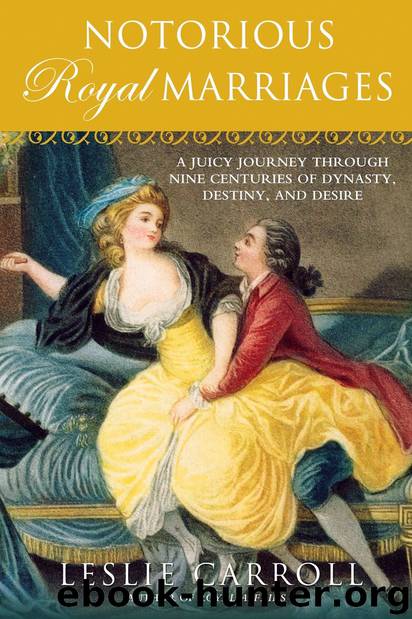Notorious Royal Marriages: A Juicy Journey through Nine Centuries of Dynasty, Destiny, and Desire by Leslie Carroll

Author:Leslie Carroll [Carroll, Leslie]
Language: eng
Format: epub
Tags: Nonfiction, History, Royalty
ISBN: 978-1101159774
Publisher: Penguin Group US
Published: 2010-01-30T16:00:00+00:00
Catherine placed this letter in a cabinet in her study and locked it away. There it remained throughout her reign, discovered after her death by the new emperor, her son, Paul. By that point, he had long surmised that his mother, Grigory Orlov, and Orlov’s brothers had had a hand in his father’s judicial murder.
In fact, even at the time of Peter’s death no one believed that the tsar had died of a violent stomachache and hemorrhoidal colic, as stated in the formal declaration of his demise. Catherine had told a former lover that her husband drank excessively on the date of his death, adding “that the illness affected his brain. . . . I had him opened up—but his stomach showed no traces of ill-health. The cause of death was established as inflammation of the bowels and apoplexy.” Indeed, the autopsy of Peter’s body confirmed that he had died of natural causes.
However, according to one witness, Peter’s “face was extraordinarily black . . . he was oozing through the skin an extravasated blood which could be seen even on the gloves which covered the hands. . . . Finally, people claim to have noticed on the corpse all the symptoms which may indicate poisoning.”
Peter’s body was dressed in the light blue uniform of his beloved Holstein guards. A large hat was tugged down over his face, obscuring the discoloration, and an ample cravat disguised evident marks of strangulation. On July 10, he was buried in the Nevsky monastery. Catherine was not present.
Two days after Archduke Paul’s eighth birthday, on September 22, 1762, Catherine was crowned empress. Her subjects didn’t seem to care that Grigory Orlov was her lover, and he remained so for another decade. Catherine had immediately recognized that if she was to remain an absolute ruler, she could never remarry because the Russian people would want (and expect) power to be concentrated in her husband’s hands.
As empress, Catherine saw herself as an “enlightened autocrat” and began her reign as an innovator and a pragmatist, convinced that the best way to discover whether a proposed law would be effective was to discuss it fully and solicit opinions from the people it would affect before implementing it. And she believed in the importance of respecting religion, but not in allowing it to influence matters of state.
Catherine supported the radical new vaccination against smallpox, founded a medical college, built hospitals, and, entirely from her own purse, funded the creation and maintenance of a foundling home that offered free care to the indigent. Her massive art collection became the basis for the renowned Hermitage. And in 1785 she took up playwriting; her works were produced, albeit under a pseudonym, at the palace.
Then there were the more mundane, but charming and deeply personal, innovations. Catherine invented an eighteenth-century “onesie” for her six-month-old first grandson. “His whole outfit is sewn together, is put on in one go and is fastened behind with four or five little hooks; around the costume there is a fringe, and in that he is perfectly well dressed.
Download
This site does not store any files on its server. We only index and link to content provided by other sites. Please contact the content providers to delete copyright contents if any and email us, we'll remove relevant links or contents immediately.
| France | Germany |
| Great Britain | Greece |
| Italy | Rome |
| Russia | Spain & Portugal |
Fanny Burney by Claire Harman(25804)
Empire of the Sikhs by Patwant Singh(22196)
Out of India by Michael Foss(16321)
Leonardo da Vinci by Walter Isaacson(11938)
Small Great Things by Jodi Picoult(6116)
The Six Wives Of Henry VIII (WOMEN IN HISTORY) by Fraser Antonia(4807)
The Wind in My Hair by Masih Alinejad(4435)
The Lonely City by Olivia Laing(4136)
The Crown by Robert Lacey(4122)
A Higher Loyalty: Truth, Lies, and Leadership by James Comey(4047)
The Iron Duke by The Iron Duke(3660)
Millionaire: The Philanderer, Gambler, and Duelist Who Invented Modern Finance by Janet Gleeson(3585)
Sticky Fingers by Joe Hagan(3462)
Alive: The Story of the Andes Survivors by Piers Paul Read(3327)
Papillon (English) by Henri Charrière(3285)
Joan of Arc by Mary Gordon(3276)
Stalin by Stephen Kotkin(3099)
Aleister Crowley: The Biography by Tobias Churton(3034)
Ants Among Elephants by Sujatha Gidla(2933)
